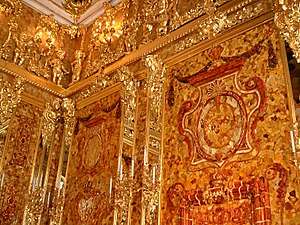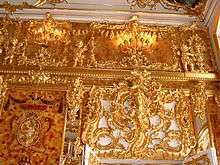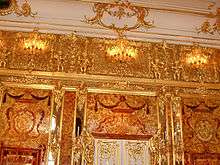Amber Room
The Amber Room (Russian: Янтарная комната, tr. Yantarnaya Komnata, German: Bernsteinzimmer, Polish: Bursztynowa komnata) was a chamber decorated in amber panels backed with gold leaf and mirrors, located in the Catherine Palace of Tsarskoye Selo near Saint Petersburg.
.jpg)
.jpg)
Constructed in the 18th century in Prussia, the room was dismantled and eventually disappeared during World War II. Before its loss, it was considered an "Eighth Wonder of the World". A reconstruction was installed in the Catherine Palace between 1979 and 2003.
The Amber Room was intended in 1701 for the Charlottenburg Palace, in Berlin, Prussia, but was eventually installed at the Berlin City Palace. It was designed by German baroque sculptor Andreas Schlüter and Danish amber craftsman Gottfried Wolfram. Schlüter and Wolfram worked on the room until 1707, when work was continued by amber masters Gottfried Turau and Ernst Schacht from Danzig (Gdańsk).
It remained in Berlin until 1716, when it was given by the Prussian King Frederick William I to his ally Tsar Peter the Great of the Russian Empire. In Russia, the room was installed in the Catherine Palace. After expansion and several renovations, it covered more than 55 square metres (590 sq ft) and contained over 6 tonnes (13,000 lb) of amber.
The Amber Room was looted during World War II by the Army Group North of Nazi Germany, and taken to Königsberg for reconstruction and display. Its eventual fate and current whereabouts, if it survives, remain a mystery. In 1979 the decision was taken to create a reconstructed Amber Room at the Catherine Palace. After decades of work by Russian craftsmen and donations from Germany, this was finally inaugurated in 2003.
Architecture
The Amber Room is a priceless piece of art, with extraordinary architectural features such as gilding, carvings, 450 kg (990 lb) amber panels, gold leaf, gemstones, and mirrors, all highlighted with candle light.[1][2][3] Additional architectural and design features include statues of angels and children.[2][3]
Because of its unique features and singular beauty, the original Amber Room was sometimes dubbed the "Eighth Wonder of the World".[2] Modern estimates of the room's value range from $142 million (2007)[4] to over $500 million (2016).[5]
History
Creation

The Amber Room was begun in 1701 with the purpose of being installed at Charlottenburg Palace, the residence of Frederick, the first King in Prussia, at the urging of his second wife, Sophie Charlotte.[6][1] The concept and design of the room was drafted by Andreas Schlüter.[6][1] It was fabricated by Gottfried Wolfram, master craftsman to the Danish court of King Frederick IV of Denmark, with help from the amber masters Ernst Schacht and Gottfried Turau from Danzig.[6][1][2]
Although originally intended for installation at Charlottenburg Palace, the complete panels were eventually installed at Berlin City Palace.[7] The Amber Room did not, however, remain at Berlin City Palace for long. Peter the Great of Russia admired it during a visit and in 1716, King Frederick I's son Frederick William I presented the room to Peter as a gift, which forged a Russo-Prussian alliance against Sweden.[1][2]
The original Berlin design of the Amber Room was reworked in Russia in a joint effort by German and Russian craftsmen.[6][1] It was Peter's daughter Empress Elisabeth who decided the amber treasure should be installed at Catherine Palace, where the Russian Imperial family typically spent their summers.[2][3] After several other 18th-century renovations, the room covered more than 55 square metres (590 sq ft) and contained over 6 tonnes (13,000 lb) of amber.[1] The room took over ten years to construct.[6][1]
Evacuation during World War II

Shortly after the beginning of the German invasion of the Soviet Union in World War II, the curators responsible for removing the art treasures in Leningrad tried to disassemble and remove the Amber Room.[6] However, over the years the amber had dried out and become brittle, making it impossible to move the room without crumbling the amber.[6] The Amber Room was therefore hidden behind mundane wallpaper, in an attempt to keep German forces from seizing it, but the attempt to hide such a well-known piece of art failed.[2]
German soldiers of Army Group North disassembled the Amber Room within 36 hours under the supervision of two experts.[1][2][3][8] On 14 October 1941, the priceless room reached Königsberg in East Prussia, for storage and display in the town's castle.[1][2][8] On 13 November 1941, a Königsberg newspaper announced an exhibition of the Amber Room at Königsberg Castle.[8]
Last days in Königsberg
Orders given by Hitler on 21 and 24 January 1945 ordered the movement of looted possessions from Königsberg.[9] This allowed Albert Speer, Reichminister of Armaments, and his administration team to transport cultural goods of priority.[9] However, before the Amber Room could be moved, Erich Koch, who was in charge of civil administration in Königsberg during the final months of the war, abandoned his post and fled from the city, leaving General Otto Lasch in command.[10]
In August 1944, Königsberg was heavily fire bombed by the Royal Air Force. It suffered further extensive damage from artillery from the advancing Red Army before the final occupation on 9 April 1945.[11]
Disappearance and mysteries
After the war, the Amber Room was never seen in public again, though reports have occasionally surfaced stating that pieces of the Amber Room survived the war.[12] Several eyewitnesses claimed to have spotted the famous room being loaded on board the Wilhelm Gustloff, which left Gdynia on 30 January 1945, and was then promptly torpedoed and sunk by a Soviet submarine.[12]
In 1997, an Italian stone mosaic that was part of a set of four stones which had decorated the Amber Room was found in Germany, in the possession of the family of a soldier who claimed to have helped pack up the amber chamber.[1][13] The mosaic came into the hands of the Russian authorities and was used in the reconstruction effort.[1][13]
In 1998, two separate teams, one German and one Lithuanian, announced they had located the Amber Room.[14] The German team pointed to a silver mine while the Lithuanian team believed the amber treasure was buried in a lagoon; neither of the two locations turned out to hold the Amber Room.[14]
In 2004, a lengthy investigation by British investigative journalists Catherine Scott-Clark and Adrian Levy concluded that the Amber Room was most likely destroyed when Königsberg Castle was damaged,[15] first during the bombing of Königsberg by the Royal Air Force in 1944 and then by the Soviets' initial burning of the castle followed by the Soviets’ shelling of the remaining walls.[15][16] Official assessments, set out in documents from the Russian National Archives written by Alexander Brusov, head of the Soviet team charged with locating the Amber Room following the war, agreed with this theory. The official report stated: "Summarizing all the facts, we can say that the Amber Room was destroyed between 9 and 11 April 1945."[17]
These dates correspond with the end of the Battle of Königsberg, which finished on 9 April with the surrender of the German garrison. A few years later, Brusov publicly voiced a contrary opinion;[18] this is believed to have been done due to pressure from Soviet authorities, who did not want to be seen as responsible for the loss of the Amber Room.[18]
Among other information retrieved from the archives was the revelation that the remaining Italian stone mosaics were found in the burned debris of the castle.[19] Scott-Clark and Levy concluded in their report that the reason the Soviets conducted extensive searches for the Amber Room, even though their own experts had concluded that it was destroyed, was because they wanted to know if any of their own soldiers had been responsible for the destruction.[20] Scott-Clark and Levy also assessed that others in the Soviet government found the theft of the Amber Room a useful Cold War propaganda tool.[21] Russian government officials have since denied these conclusions. Adelaida Yolkina, senior researcher at the Pavlovsk Palace, reportedly stated: "It is impossible to see the Red Army being so careless that they let the Amber Room be destroyed".[22]
After the report was made public, Leonid Arinshtein, who was a lieutenant in the Red Army in charge of a rifle platoon during the Battle of Königsberg, said: "I probably was one of the last people who saw the Amber Room".[23] At the same time, he explained that the whole city was burning due to artillery bombardments, but also denied allegations that the Red Army burned the city on purpose by saying: "What soldiers would burn the city where they will have to stay?"[23]
A variation of this theory by some present-day residents of Kaliningrad (formerly Königsberg), is that at least parts of the room were found in the Königsberg Castle cellars after World War II by the Red Army. The Amber Room was allegedly still in good condition; this was not admitted at the time so the blame could fall upon the Nazis. To preserve this story, access to the ruins of the castle, which was allowed after World War II, was suddenly restricted to all, including historical and archaeological surveys, but the room is said to be in a storehouse near Königsburg Castle.[23]
Then in 1968, despite academic protests worldwide, Soviet Premier Leonid Brezhnev ordered the destruction of Königsberg Castle, thus making any onsite research of the last known resting place of the Amber Room all but impossible.[23] In more recent years, the search for the Amber Room has continued in different locations including near Wuppertal, Germany.[24]
Another hypothesis involves a bunker in Mamerki in northeastern Poland, or that Stalin ordered the Amber Room replaced with a replica prior to its looting, hiding the original. The main problem with finding the Amber Room is that the Nazi regime hid many items in many difficult-to-reach places, usually without documentation, leaving a wide search area. Even as early as 1939, the Germans moved items to destinations far from Europe, as in the case of SS Minden, which carried 4 tons of gold (equal to £100,000,000), not found until 2017. The search for the Amber Room has also been halted by authorities. In the case of Frýdlant castle it was halted because of the historic value of castle.[25][26][27]
Reconstruction

In 1979, the Soviet government decided to construct a replica of the Amber Room at Tsarskoye Selo, a process that was to last 24 years and require 40 Russian and German experts in amber craftsmanship.[1][2] Using original drawings and old black-and-white photographs, every attempt was made to duplicate the original Amber Room. This included the 350 shades of amber in the original panels and fixtures that adorned the room.[28] Another major problem was the lack of skilled workers, since amber carving was considered a nearly lost art form.[28]
The financial difficulties that plagued the reconstruction project from the start were solved with the donation of $3.5 million from the German company E.ON.[29] By 2003, the work of the Russian craftsmen was mostly completed.[28] The new room was dedicated by Russian President Vladimir Putin and German Chancellor Gerhard Schröder at the 300th anniversary of the city of Saint Petersburg.[30]
In Kleinmachnow, near Berlin, there is a miniature Amber Room, fabricated after the original.[31] The Berlin miniature collector Ulla Klingbeil had this copy made of original East Prussian amber.[31]
In popular culture

Games
- In the video game Raid: World War II (2017), the player is tasked with locating and stealing the Amber Room at a Nazi train yard.
Literature
- The Amber Room provides the central plot device in Steve Berry's first novel The Amber Room (2003).
- The Amber Room features in other novels including Faye Kellerman's Murder 101 (2014); Wesley Chu's Time Salvager (2015); Philip Kerr's The Other Side of Silence (2016); Ruta Sepetys' Salt to the Sea (2016); Lucy Ribchester's The Amber Shadows (2016); and Clive Cussler's The Romanov Ransom (2017). The Louise Penny Inspector Gamache novel "The Brutal Telling" (2009) also makes brief reference to the Amber Room.
- The Amber Room is central to the plot in Sam Eastland's (a pseudonym of Paul Watkins) The Red Moth (2013) in which a Russian team attempt to prevent it leaving the Catherine Palace.
Television
- The Amber Room was featured in Season 1 of Expedition Unknown. Based on no hard evidence but only hearsay regarding what the Nazis did with the treasure, Host Josh Gates explored two areas of Germany including bunkers and a 17th century silver mine in a made-for-TV "search" for the relics.
- A fictional music box from the Amber Room is the MacGuffin plot device throughout the first two seasons of the American television series White Collar.
See also
- Art of the Third Reich
- Nazi gold train
- Siege of Leningrad
- Štěchovice Treasure
References
- RIA Novosti 2010.
- About 2014.
- St. Petersburg 2001.
- Jess Blumberg (July 21, 2007). "A Brief History of the Amber Room". Smithsonian Magazine. Retrieved April 24, 2016.
- Marilyn Malara (April 23, 2016). "Historian claims to have struck gold at Nazi bunker". UPI. Retrieved April 24, 2016.
- Smithsonian Institution 2014.
- Wermusch 1991, p. 15.
- Torney 2009, pp. 185–186.
- Toptenz 2014.
- Los Angeles Times 1986.
- Spiegel 2014.
- Lucas 2000, pp. 25–28.
- Seattle Times 1997.
- Scotland on Sunday 2006.
- Guardian 2004.
- Denny 2007, p. 163.
- Khatri 2012, pp. 90–95.
- Scott-Clark & Levy 2004, pp. 309–330.
- Scott-Clark & Levy 2004, pp. 322–323, 328.
- Scott-Clark & Levy 2004, pp. 108–109, 325.
- Scott-Clark & Levy 2004, p. 108-109, 325.
- Scott-Clark & Levy 2004, pp. 301–313.
- ABC News 2004.
- "Go Inside Search for Nazi-Looted '8th Wonder of World'". NBC News. Retrieved Feb 3, 2020.
- "10 Rumored Locations Of The Lost Amber Room". Listverse. Jul 28, 2018. Retrieved Feb 3, 2020.
- "Treasure Hunters Claim They Have Found the Long Lost Nazi Amber Room". Jun 23, 2017. Retrieved Feb 3, 2020.
- "r/UnresolvedMysteries - Where is the Amber Room?". reddit. Retrieved Feb 3, 2020.
- Russia Beyond the Headlines 2013.
- Pravda 2003.
- Telegraph 2004.
- AskMen 2004.
Sources
Printed
- Denny, Isabel (2007). The Fall of Hitler's Fortress City: the Battle for Königsberg, 1945. MBI Publishing. ISBN 978-1935149200.CS1 maint: ref=harv (link)
- Khatri, Vikas (2012). World Famous Treasures Lost and Found. Pustak Mahal Publishing. ISBN 978-8122312744.CS1 maint: ref=harv (link)
- Lucas, James (2000). Last Days of the Reich: The Collapse of Nazi Germany, May 1945. Cassell Publishing. ISBN 978-0304354481.CS1 maint: ref=harv (link)
- Scott-Clark, Catherine; Levy, Adrian (2004). The Amber Room: The Untold Story of the Greatest Hoax of the Twentieth Century. Atlantic Books. ISBN 1-84354-340-0.
- Torney, Austin (2009). The Guide to the All-Embracing Realm of the Ultimate. Torney Publishing. ISBN 978-1448617272.CS1 maint: ref=harv (link)
- Wermusch, Günter (1991). Die Bernsteinzimmer Saga: Spuren, Irrwege, Rätsel (in German). Yale University. ISBN 978-3861530190.CS1 maint: ref=harv (link)
Online
- "A Brief History of the Amber Room". Smithsonian Institution. 2014. Retrieved 19 February 2015.
- "Amber Room Hunt Makes Lake the Tsar Attraction". Scotland on Sunday. 2006. Retrieved 19 February 2015.
- "Amber Room Remnants Found? — Discoveries Delight Russian Art Experts". Seattle Times. 1997. Retrieved 19 February 2015.
- "Catherine Palace". St. Petersburg. 2001. Retrieved 23 February 2015.
- "Erich Koch, Regarded as One of Cruelest of Hitler's SS Men, Dies in Prison at 90". Los Angeles Times. 1986. Retrieved 19 February 2015.
- "Greed, Glory and a Tsar's Lost Treasure". The Guardian. 2004. Retrieved 22 February 2015.
- "Mystery of the Amber Room Resurfaces". ABC News. 2004. Retrieved 19 February 2015.
- "Red Army, Not the Nazis, Destroyed Tsar's Amber Room". Telegraph. 2004. Retrieved 19 February 2015.
- "Resurrecting Königsberg: Russian City Looks to German Roots". Der Spiegel. 2014. Retrieved 19 February 2015.
- "Restoration of the Amber Chamber is Coming to an End". Pravda. 2007. Retrieved 26 June 2007.
- "Russian Jeweller Recreates the Amber Room In His Workshop". Russia Beyond the Headlines. 2013. Retrieved 19 February 2015.
- "Top 10 Famous Pieces of Art Stolen by the Nazis". Toptenz. 2014. Retrieved 19 February 2015.
- "The Amber Room: History, Figures, Facts and Mysteries" (in Russian). RIA Novosti. 2010. Retrieved 25 February 2015.
- "The Amber Room: Long Lost Treasure". AskMen. 2004. Retrieved 19 February 2015.
- "The Amber Room". About. 2014. Retrieved 19 February 2015.
External links
![]()
- Amber Room 3D panorama with high-resolution pictures of decor elements and function drag and zoom by Classic Studio
- Bibliographical Database of the International literature about the Amber Room by Peter Bruhn